San Diego Through the Years
When my family migrated west in 1957, San Diego’s Lindbergh Field replaced Chicago-Midway and O’Hare as my airport domicile, providing new shooting opportunities: Bonanza Air Lines, PSA and Western Air Lines, along with more familiar carriers. These pictures are pretty much in chronological order. Click on them for a bigger image.
Image(s) added on March 24, 2017.
I began shooting pictures at SAN in 1958. Above, American DC-7B N365AA arrives in the late-day sun on August 24. I would ride this same airplane from Chicago-Midway to Phoenix two years later. Below: On September 12, three American Flagships appear together, a bit of a rarity at this airport, especially to have three varieties lined up; from left, a DC-6, DC-6B and DC-7B. Many thanks to my good friend, Geoffrey Thomas, who arranged to have these two black-and-white pictures colorized for the occasion, by his talented friend, Benoit Vienne.
The airport’s open gates offered in-your-face photography, as evidenced by American’s DC-7 Flagship Virginia, N311AA, as the pilot receives his departure clearance salute.
N90747, an American “straight” DC-6 named Flagship San Antonio, as seen from the top of the adjacent gate boarding steps.
It appears I stepped out onto the ramp for this shot of idle United DC-6 N37513, Mainliner Mt. Hood. Such a transgression was not a problem in those days.
At the same gate on a cloudy day, DC-6B N37570, Mainliner Hawaii, was one of the few remaining United airplanes still wearing the older livery in 1958. This DC-6B normally operated coach service flights on the Honolulu route from Los Angeles and San Francisco.
United scheduled several daily Convair 340 flights from San Diego, all to Los Angeles. N73120, Mainliner Merced, poses with the plant in which she was built visible in the background.
Having arrived from Phoenix, Yuma and El Centro on June 19, 1959, a sturdy Bonanza DC-3 awaits boarding passengers with No. 2 engine still running. Note the little electric golf cart under the wing, plenty large enough for light passenger traffic. Bonanza had no dedicated gates at SAN and parked wherever one was vacant.
In less than 5 minutes, N491 pulls out of the gate, headed for Los Angeles via Oceanside and Santa Ana.
Less-frequent DC-3 visits to SAN were made by Las Vegas Hacienda, Inc., offering bargain-fare junkets to Sin City. $27.50 would buy you a roundtrip ticket, hotel room, bottle of champagne, tote bag and $5 in chips. N67674 flew all over the world and wound up scrapped in Vietnam. Thanks to Ed Coates for this information; see http://www.edcoatescollection.com/
San Diego-headquartered Pacific Southwest Airlines began replacing its DC-3s with the acquisition of two ex-Capital DC-4s in 1955. From San Diego, PSA flew to San Francisco via Los Angeles or Burbank with SFO nonstops on Fridays and Sundays only. N86557 retains its former owner’s livery, including square outlines over the oval windows, a trick used to mimic a more-modern, pressurized DC-6.
Here’s the sister ship, N88747. More sensitive to its center of gravity, the DC-4s usually were stabilized during passenger boarding and deplaning with a post hanging from the tail skid. PSA acquired two more DC-4s in 1956 to complete phase-out of its DC-3s.
Seen through the open-air baggage claim area in this October 5, 1958 photo, Western’s immaculate DC-6B N93125 shines like a dime.
I took this and several other pictures from a vacant second-floor office in the terminal building (seen above in the Hacienda DC-3 picture), my secret shooting spot. Western Champagne Flight 208, dubbed The Californian, awaits passengers, bound for Phoenix, Denver and Minneapolis/St Paul.
Two Western DC-6Bs appear simultaneously, which was not the norm; one was probably operating behind schedule. Weather radar, mandated on all “large” airliners by July 1, 1960, was not yet installed on these two airplanes. N93119, in the foreground, was the 800th DC-6 built.
A closer view of the second DC-6B, N91307. It’s all coach configuration is confirmed by the small “C” next to the fleet number on the nose. A rather outdated set of boarding steps was utilized for Western’s infrequent multiple operations.
At the same gate, on August 20, 1958, I snapped this picture of Art Linkletter and two of his daughters. I don’t recall the event, but believe it had something to do with the Fiesta del Pacifico celebration, held annually in the summertime. Linkletter lived much of his life in the San Diego area.
From that same office window I caught the unique dual colors of Continental and United on DC-6B N90961, used mainly for CO/UA interchange service; somehow it wandered into San Diego on a solely United flight. An aircraft carrier is visible in the left background, anchored across the bay at North Island.
A father and sons gaze at this United DC-7, with another in the background on an August 1959 evening. It was just about dark but still light enough to shoot with no flash. The ‘T’ forward of the aft two windows tell us this is a Custom Coach airplane. Note the coin-operated telescope at the gate!
Bonanza brought the first jet-powered service to San Diego in Spring 1959, between Los Angeles and Phoenix via Santa Ana, El Centro, and Yuma, with Fairchild F-27A Silver Darts.
Above & Below: A rare sight was two Bonanza airplanes at SAN simultaneously, and in this case two types. A single DC-3 service was retained to serve Oceanside until Bonanza became the first all jet-powered airline in America and discontinued service there.
The Convair division of General Dynamics built 102 jetliners at Lindbergh Field, 65 Convair 880s and 37 Convair 990s. This old General Dynamics photo shows the prototype 880 gliding over the fence for landing. Look at the people lined up along the gates and on top of adjacent buildings to witness the event. This was probably taken soon after the type’s January 27, 1959 maiden flight, which ended at North Island NAS as planned. Perhaps it is its first return to Lindbergh Field. Regardless, we get a nice view of the terminal building from the front side.
Just by chance I was at the airport on August 10, 1959, to witness the first flight of N8801E, third in the 880 flight-test program. Jumping up onto a set of boarding steps, I caught a profile of the new jetliner, about to turn onto Runway 27 for its maiden sortie.
Right behind N8801E, another of three 880s painted in house colors, N803TW, taxied out for takeoff. Second to fly, on March 31, 1959, its engine nacelles were left in bare metal.
No, Continental didn’t serve San Diego when this picture was taken in August 1959, but its aircraft flew American-Continental interchange service on the L.A.-San Diego-El Paso-San Antonio-Houston route. N8210H was serviced by American, albeit with a set of United steps.
This is one of my favorite shots. The sun was just perfect on DC-6B N90757, American’s Flagship Oklahoma City, as it waited clearance for takeoff. What makes it special for me is the fact that my dad was aboard. This was the origination of American/Delta Interchange Flight 902, headed for Birmingham, Alabama via LAX, Phoenix, Dallas and Atlanta.
Admittedly this is not a prize-winning photo, but it reflects the American-Delta-Interchange service, in this case flown with a National DC-6B that came through late in the evening. N8228H was written off after a ground collision with a Northeast Viscount at Boston on November 15, 1961, less than six months after I photographed her.
My early San Diego pictures were nearly all shot with 620 black & white print film. Occasionally I tossed in a roll of color as evidenced by this June 1960 image from my trusty 620 Tourister camera, of PSA’s first Electra, N171PS, with another in the background. It even shows one of the airline’s Jeep utility vehicles.
Sister ship N173PS is towed from Gate 5 with PSA’s combination power/engine start/tow truck, headed for the hangar.
The sun was breaking through a typical marine layer of low clouds as United DC-7 N6331C posed for my camera lens.
A rare visitor at the time, TWA 049 Constellation N86502 operated a charter flight up to San Francisco, carrying the Moscow Symphony Orchestra. I just happened to be at the airport to capture it on film, February 26, 1960.
Orchestra members can be seen boarding their TWA charter flight in this view looking down the ramp. DC-6s of American and United flank a PSA Electra in the background.
Not long after PSA retired its DC-4s, I took this picture of two, adjacent to the company hangar, from a Coast Rotors helicopter when the friendly pilot gave me a short ride. Sorry it’s not very sharp.
American began flying Boeing 720s to San Diego in August 1960, but occasionally a 707 would sneak in. Straight-pipe 707-123 N7518A, Flagship Tennessee, sits in the late-day sun at Gate 6.
United Air Lines began Jet Mainliner service to SAN with 720-022s on September 13, 1960 over a curious pattern at the beginning, one-way from LAX, then nonstop to San Francisco, northbound only. N7205U is seen at Gate 1 on July 1, in town for ground crew familiarization and a gate fit-check.
By May 1961, United was operating DC-8s from San Diego to Los Angeles, which is how I got my first ride on a Douglas jet. Unlike some of the early deliveries, N8020U flew out its career without an upgrade to turbofan engines.
Newly formed non-sked Northern Express acquired this ex-American Convair 240 from F.B. Ayer, not long before I photographed her on May 29, 1961. The upstart reportedly acquired two more Convairs before ceasing operations barely a year later. With the high sunlight I didn’t get a very good picture, but recognized N94238 as the former Flagship Lake Erie.
National Airlines began serving San Diego on June 11, 1961, with Lockheed 188 Electras. One of my early color photos shows N5009K that day, departing for LAX in the late afternoon, after having been delayed along the way because of various inaugural ceremonies.
A year later, National upgraded its service to DC-8-21s. N6573C appears ready for engine start at Gate 1.
Seen on June 18, 1961, the fourth Convair 990 off the assembly line was the first to be painted in an airline livery, although it never went to American Airlines, which received all of its airplanes in bare-metal colors. This one wore N5604 for only a short time, and later went to Garuda. The registration was finally assigned to the 36th 990 and delivered to American nearly two years later.
Brother Bob took this picture in July 1961, out the window of an American 720 as it climbed away from Runway 27. That’s Harbor Island out there, at the beginning of its commercial development; you would not recognize it today from this shot. Across the water is a hangar at North Island NAS.
My notes say this is a Skycoach DC-4, seen on May 30, 1961, as it pulls to a stop and an agent runs from his tug to install the tail post; perhaps PSA did the ground handling. That livery looks just like Great Lakes Airlines, also controlled or owned by former Pan Am pilot Irving E Herman, who swapped his airplanes between numerous “ghost” airlines.
Formerly N322AA with American Airlines, this DC-7 was acquired by Overseas National Airways and pressed into service with minimal livery changes. I caught her on a typical overcast morning at Lindbergh Field in August 1961.
VIASA’s first Convair 880M. YV-C-VIA, receives finishing work, shortly before its August 1, 1961 delivery. Later sold to Cathay Pacific, it was destroyed by sabotage over Pleiku, South Vietnam 12 years later.
An example of the bare-metal American livery is seen on N5614, awaiting delivery adjacent to the assembly factory in March 1962.
I got what would turn out to be my only Convair 340 ride when United’s Mainliner Omaha, N73102, took me up to Los Angeles on June 30, 1962. Second off the assembly line and delivered in 1952, it survives today as a turbine-powered Convair 580 with Honeywell. Click here for an update on this workhorse.
Pacific Air Lines was authorized to serve San Diego in 1962 and operated up to Los Angeles and points north, but could not carry LAX passengers; go figure. N40438 is seen on the south side of the field. I caught a ride on her in 1964, from San Jose to San Francisco. Look closely; there’s the prototype Convair 990 in the background.
Operated for Logair by Zantop Air Transport, this vintage C-46 was almost certainly operating some kind of military cargo charter when I photographed it on March 24, 1962, completing an engine run-up.
For an enthusiast like me, one of the benefits of living in the San Diego area was the ability to ride a variety of aircraft types on short flights to and from Los Angeles at reasonable prices. I got my first Convair 880 ride on April 17, 1962 aboard Delta’s N8801E, the same airplane I earlier photographed about to depart on its maiden flight. It is seen here disembarking passengers before I headed north on Golden Crown Flight 895.
United was still serving San Diego with DC-7s in June 1962, as evidenced by N6354C, another Custom Coach example. Talk about a short-timer, it only served six years with United. After briefly flying with another carrier, the Seven was retired at Burbank in 1966 and broken up.
On June 26, Continental brought a brand-new 720B to San Diego for a demonstration flight, giving city officials and travel agents a one-hour aerial tour of Southern California. Still working summers at La Jolla Travel, I was able to talk my way on board.
Seen on Independence Day 1962, 720-023B Astrojet N7531A is parked on the north side, just off Harbor Drive, no doubt idled due to holiday scheduling. The tail number could use a little touchup.
Later that year, American Royal Coachman DC-7B N349AA sits at the same location, undergoing an engine change.
That night I returned with a tripod for this shot, with a reflection of the Moon atop the fuselage. It looks like the engine change had been completed by then.
I took this shot moments after getting off Western Electra N7136C, on July 8, 1962, following a ride down from Los Angeles. Note that military truck and all the B-4 bags being unloaded; there was a large contingent of military personnel on board with me.
DC-7Cs never operated in scheduled service at Lindbergh Field, which is why N2281, belonging to charter specialist Paramount Airlines (another Irving Herman-controlled company), quickly caught my attention in July 1962. First delivered to Mexicana, it wound up as a disco in Valencia, Spain in the 1980s.
Another shot of a United 720-022, this time N7218U, departing on August 17, 1962.
American took travel agents up for a ride aboard Convair 990 N5608 on October 27. Once again I snuck aboard for the ride. The type’s unique anti-shock bodies on the wings are visible in this picture.
American DC-7B N339AA, Flagship Wyoming, taxis to the gate on Christmas Day 1962. My mother, dad and I boarded her that morning for a short flight up to LAX to attend a wedding reception the following day.
Shortly after takeoff on that crystal-clear Christmas morning, I took this shot of La Jolla. Miramar NAS is visible at the top of the picture, but no I-5 Interstate, which had not yet been constructed. It was a 4-hour drive up to L.A. in those days. By now I was shooting more 35mm color slides but still kept my old Tourister at the ready. A roll of Kodachrome with processing represented more than a week’s allowance!
United was still operating Convair 340s into SAN, for short hops up to LAX. N73154 sports an updated oval logo ahead of the boarding door. Ground personnel appear to be looking for something small on the ramp in this picture; a nut or washer?
Trans California was an intra-state carrier that tried, unsuccessfully, to compete with PSA. Its five aircraft were probably the only Constellations to fly regularly scheduled flights into San Diego, and just for a year or less. N102A, a model 749A, awaits customers in this February 1963 photo.
That year Western was operating DC-6Bs between San Diego and Mexico City, as evidenced by N93131, sitting at Customs & Immigration on the Harbor Drive side of the field.
I rode an American Convair 990 nonstop to Chicago on January 28, 1963, setting a speed record on the route, of 2 hours, 48 minutes. We took off to the east, allowing this brief glimpse of the terminal building. The enclosed concourse is partially visible on the left, built to accommodate ticket counters for Delta, National and the relocation of Bonanza. Check out Budget Rent-A-Car’s $3-a-day rental rates on the billboard below. Incidentally, the SAN-ORD record only stood 24 hours, eclipsed by the same flight just a day later: 2 hours, 41 minutes.
American’s DC-7B Royal Coachman flights were still passing through SAN in February 1963. N343AA pulls into Gate 6. Originally N348AA, it was repossessed from Vias Internacionales de Panamá in October 1962 and given a new tail number.
On the field’s south side, Flying Tigers 1049H Constellation N6918C roars to life on June 19, about to depart on a military charter.
Originally built for Capital Airlines, PSA’s sixth and final factory-delivered Electra sits at the company hangar just a day after its May 1963 delivery flight from Burbank. Having received upgrade modifications following early Electra accidents, it wears “SUPER Electra JET” titles.
I don’t have an exact date for this picture, but know it was taken in 1963, probably springtime. American Airlines Ford Tri-Motor NC9683, which now hangs in the Smithsonian Air & Space Museum in Washington, DC, was flown by my father while it was in service with the airline back in the early 1930s. Before the handover ceremony, it toured North America for various displays and functions. My parents were invited to tour the airplane when it stopped at Lindbergh Field. Dad was offered a ride in the airplane that day but declined, having had enough hours in the Tin Goose! Originally in back & white, the image was meticulously colorized by Benoit Vienne and given to me as a gift, for which I am grateful beyond words.
707-123B N7503A was Flagship California before conversion to turbofan power. It inaugurated jet service across the USA, from Los Angeles to New York, on January 25, 1959. Using Kodachrome 25 film, I must have had a tripod set up.
My AA ramp buddies let me aboard for a few shots. Archaic by today’s standards, the 707 cockpit featured a myriad of round dials.
Just behind the front boarding door, a cozy 6-seat first-class lounge reflects the relative luxury of flying aboard the early jets.
Plenty of seats in the main first-class cabin; how times have changed.
Even coach wasn’t all that uncomfortable. Not readily apparent in this picture is the much-more generous legroom than we enjoy these days.
Just a month after delivery to American, turbofan-powered 720-023B N7543A catches the first rays of sunlight as it is prepared for departure in April 1961 with a pilot heading up the steps to his front office.
With the updated “Super” titles, N172PS climbs from Runway 27. A soon-to-be delivered Garuda Convar 990A is visible in the background, at the Convair plant.
These were the days, when you could walk right out onto the ramp in order to grab a picture. An American DC-6 receives attention on its transit stop. In the background, a PSA billboard advertises 75-minute flights to San Francisco for $19.85 plus tax.
By June 1963 Western had become the third jet operator at San Diego. I caught 720-047B N93141 pushing back. Later sold to Avianca, it was written off after the nose gear collapsed on landing at Mexico city on August 16, 1976.
American Convair 990 Astrojet N5618 waits to line up behind the 720B for takeoff on Runway 27. It still has not been converted to ‘A’ standards with the lengthened engine nacelles.
On June 6, 1963, President John Kennedy visited San Diego. I caught Air Force One about to land on Runway 27.
The President leaves from the terminal entrance after his motorcade passed between Air Force One and that point inside the airport boundary. Sitting to his right and facing him is California Governor Pat Brown. A demonstrator on the left holds up a “Free Cuba Now!” sign but the crowd otherwise looks friendly. I was not using a telephoto lens when taking these pictures. We all know what happened barely five months later.
January 25, 1964, approaching San Diego from SFO and LAX, on PSA ElectraJET Flight 136, N171PS. That’s La Jolla dead ahead then San Diego, and Point Loma visible to the right of the flight engineer. PSA was great about leaving the cockpit door open, sometimes right up until gear down! The Electra cockpit was so wide that two sets of throttles were required so both pilots could reach them.
Turning final onboard a PSA Electra July 28, I caught a bit of the San Diego skyline and Coronado Island in the background. In the center is the El Cortez Hotel, which was the city’s tallest building when I moved there only six years earlier.
By comparison, here’s another picture taken April 13, 1964, again from a PSA Electra. More skyscrapers alter the skyline. An aircraft carrier can be seen tied up at North Island.
AFA – American Flyers Airline operated numerous military charter flights into and out of Lindbergh Field. This August 1963 shot also shows PSA’s home office and hangar in the background.
At the same parking spot, Saturn Airways DC-6B N90772 awaits a load of soldiers or sailors. Originally American’s Flagship Rhode Island, it joined Saturn in 1960 with the same tail number.
Pulling away from the gate, the Douglas reveals is registration. It later went to the Chilean Air Force, then Gomes & Warra Aircraft Corp, and was ditched near Exuma Point, Bahamas on December 2, 1989.
That same summer, Braniff El Dorado DC-7C N5906 operated some kind of charter flight into SAN. Based on the steps and battery cart, it appears United took care of the ground handling.
On November 26, I hopped a PSA Electra up to LAX, and caught American 720-023B N7545A as we turned onto the departure runway.
A month later, in the late-day sun, a United 720 is visible in the background, behind American 707-123B N7522A.
My Lindbergh Field photo ops were few and far between after I moved up the coast, but on June 6, 1966, I came though on my way to Orlando (that’s another story), and caught 727-22 N7015U on the ramp, still in its original colors. Delivered two years earlier, N7015U flew with United for 27 years and was retired in 1991.
A year later, I caught PSA 727-14 N973PS at the then-new terminal complex.
Fast-forward 26 years! I visited San Diego In January 2003 while working on a story for Airliners Magazine. From the roof of the Sheraton Hotel on Harbor Island, a friendly security guard granted me the opportunity to capture this sweeping view of Lindbergh Field’s now-massive terminal complex. In fact, part of it is cut off on the right-hand side. What a stark contrast to the old facility on the opposite corner of the airport, where I spent so much time.
Taken from the same spot where I photographed Air Force One landing 40 years earlier, I caught Southwest 737-3H4 N644SW coming over the fence, then got on the Interstate, seen at the bottom of the picture, and headed back up the coast to Hermosa Beach. Farewell, SAN!
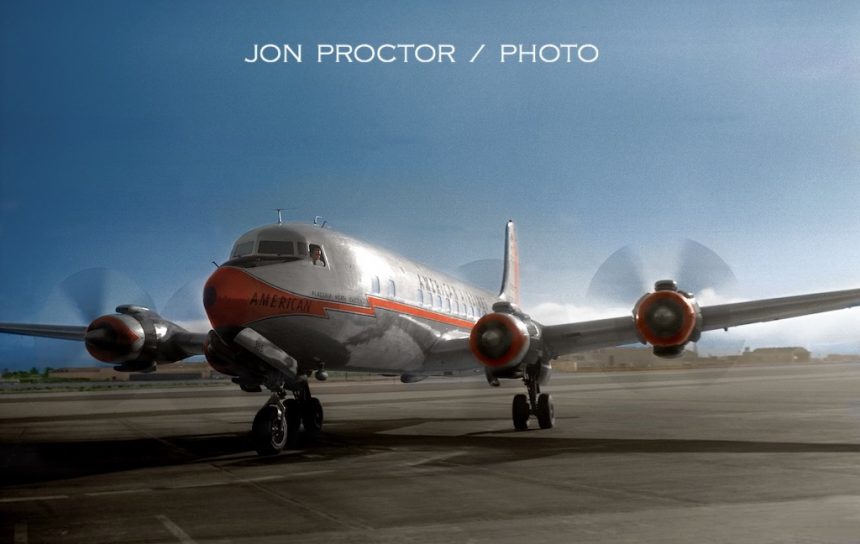




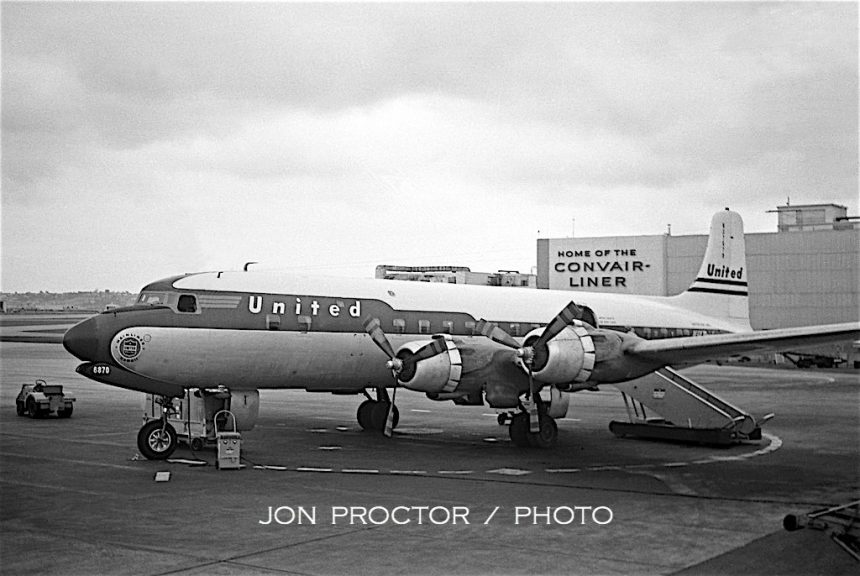

















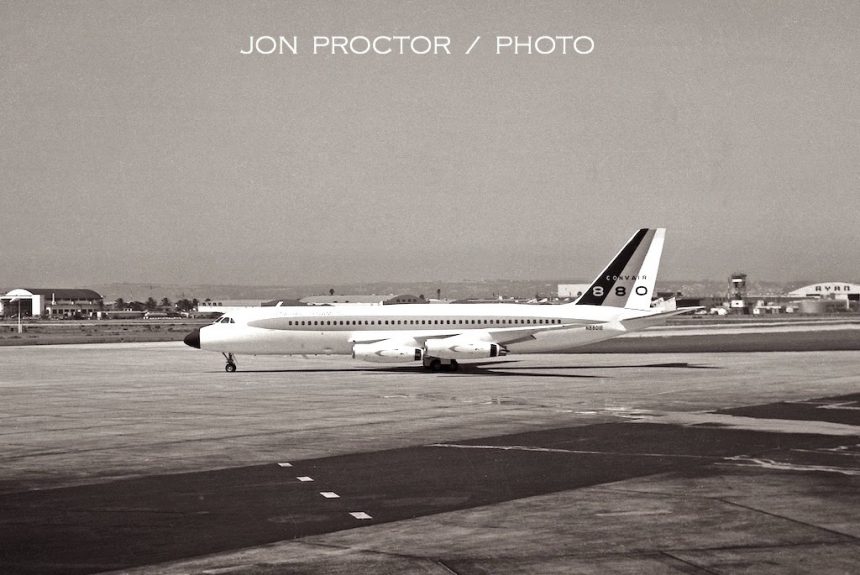

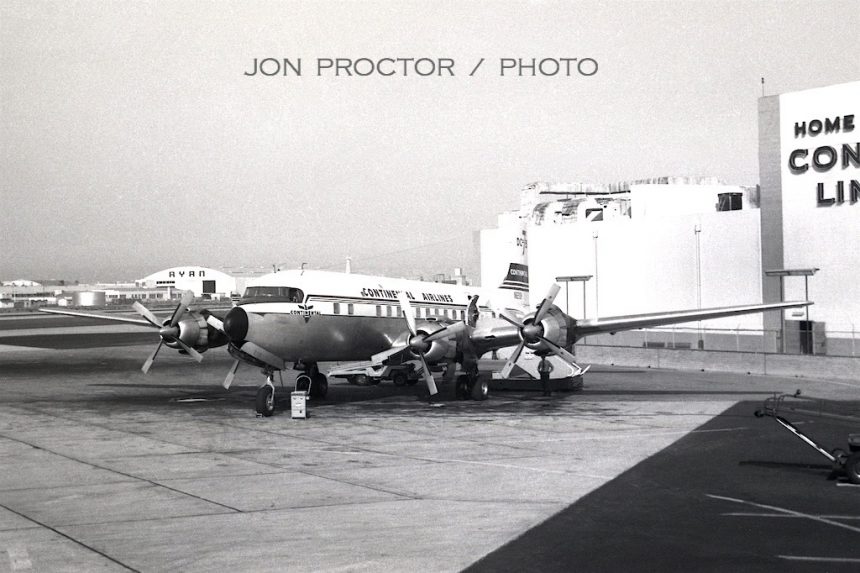


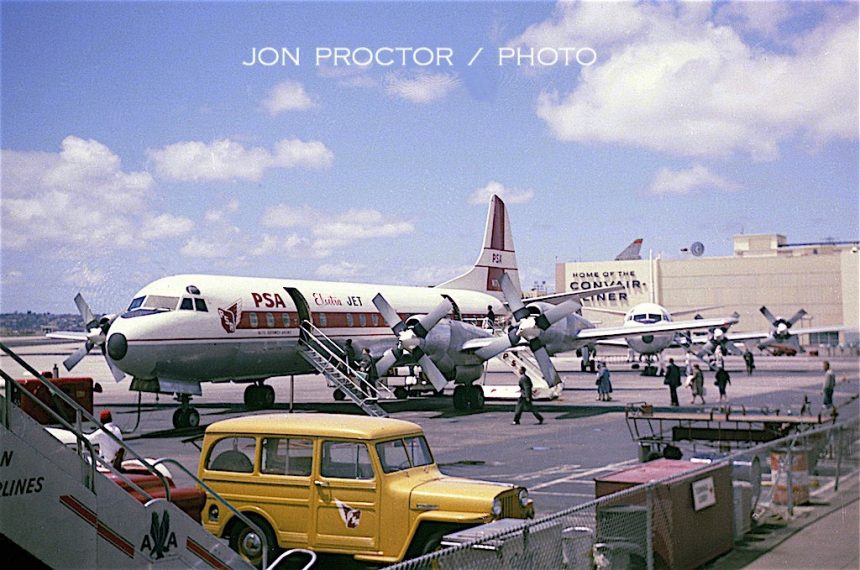

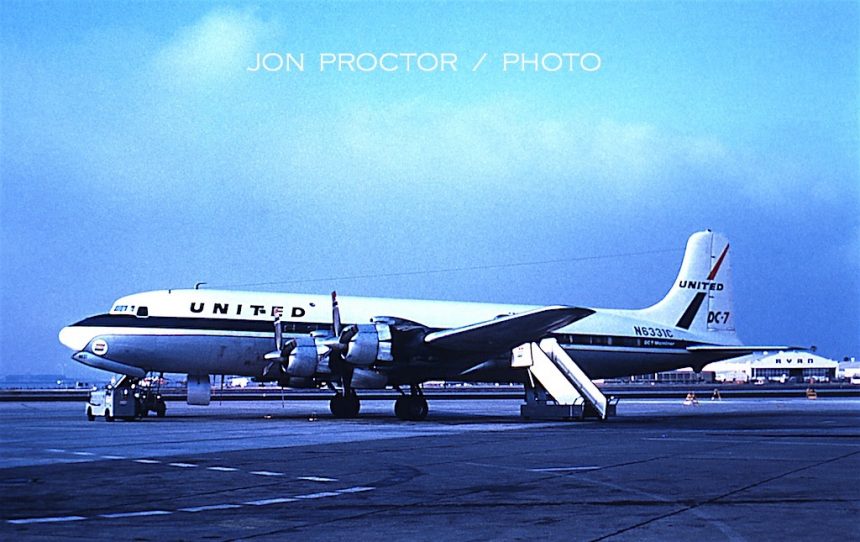


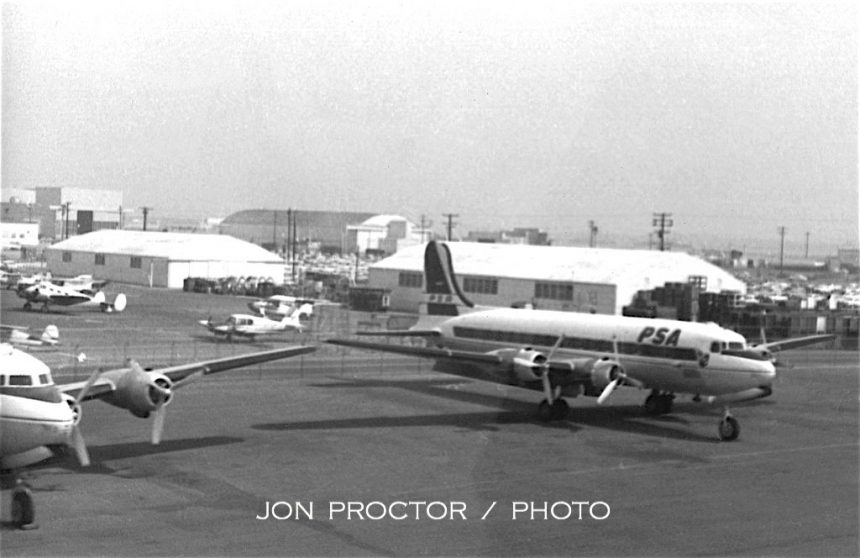

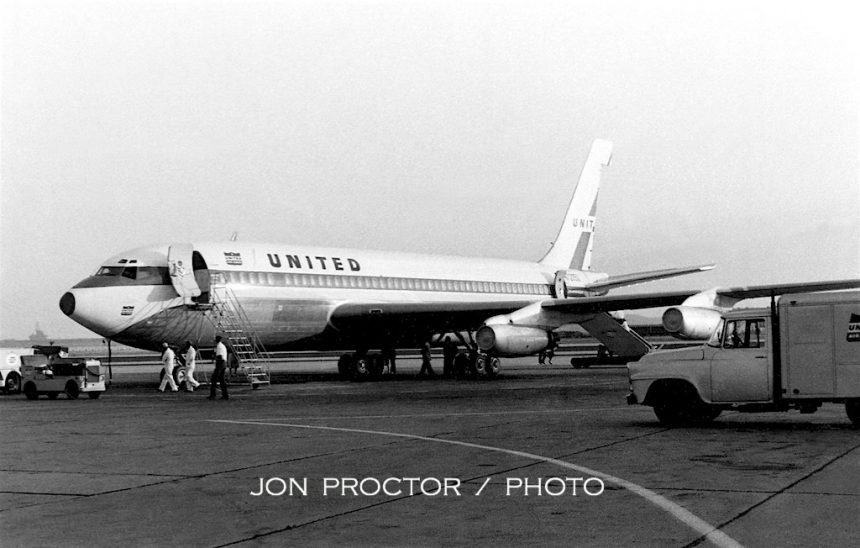
















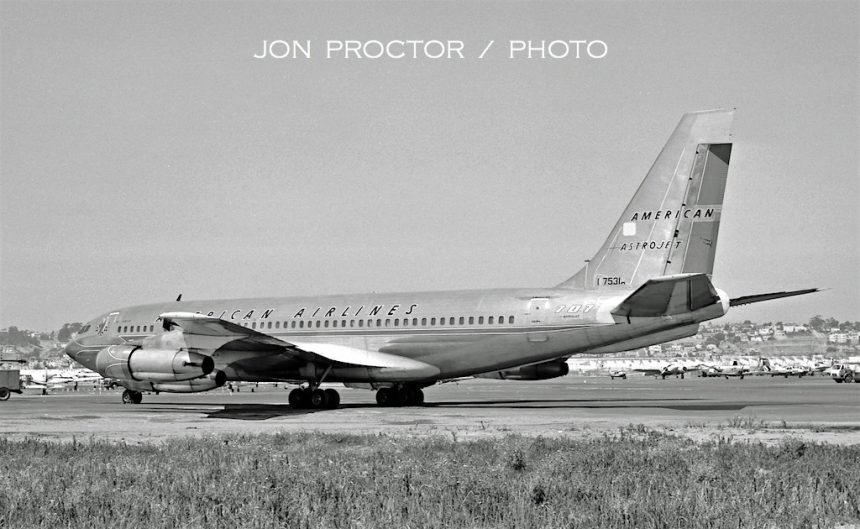
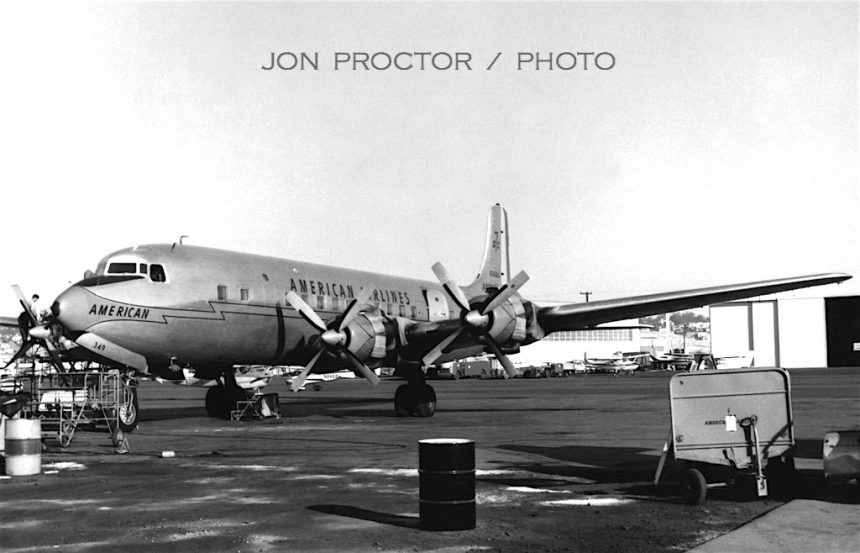



























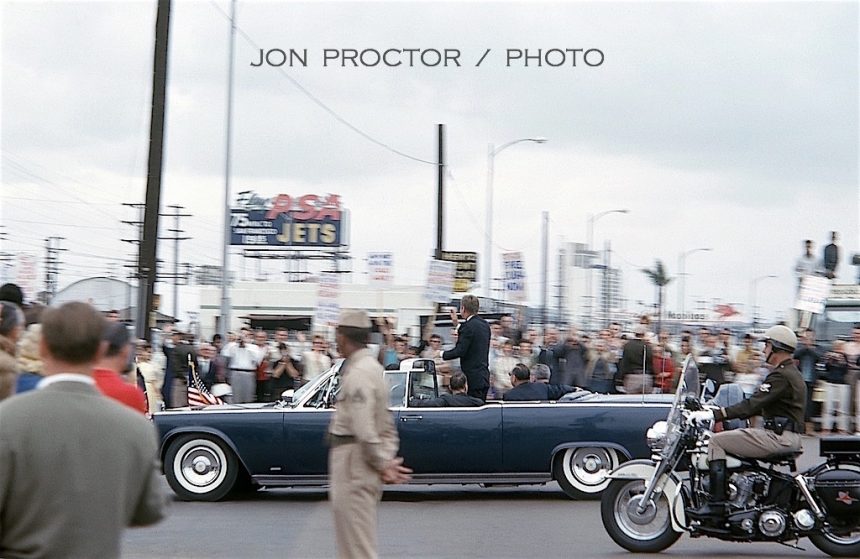









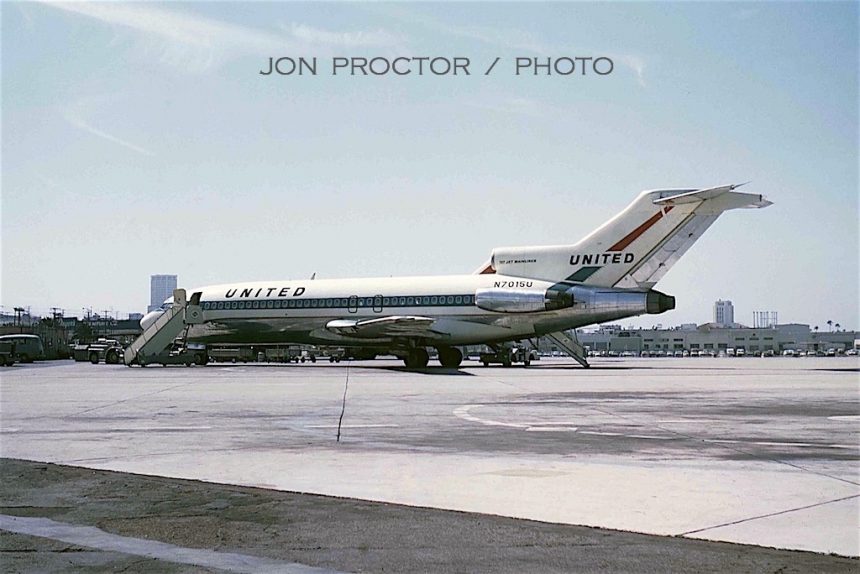
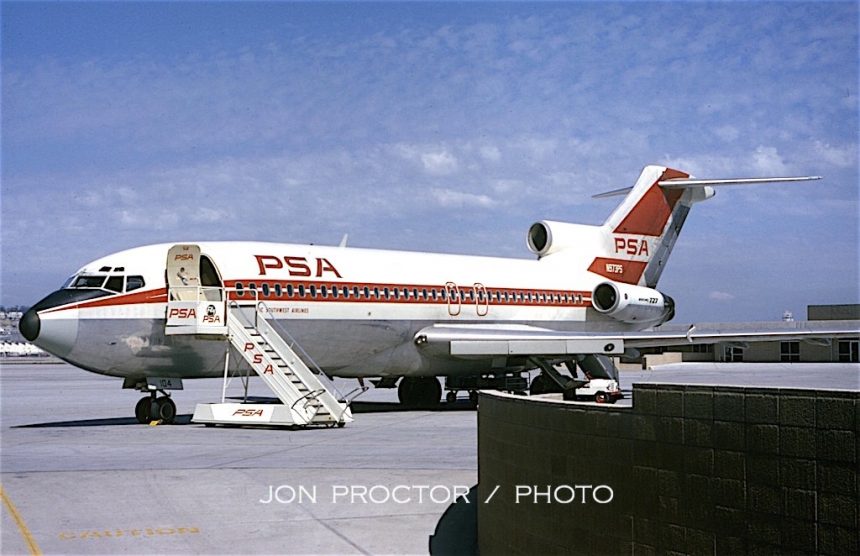
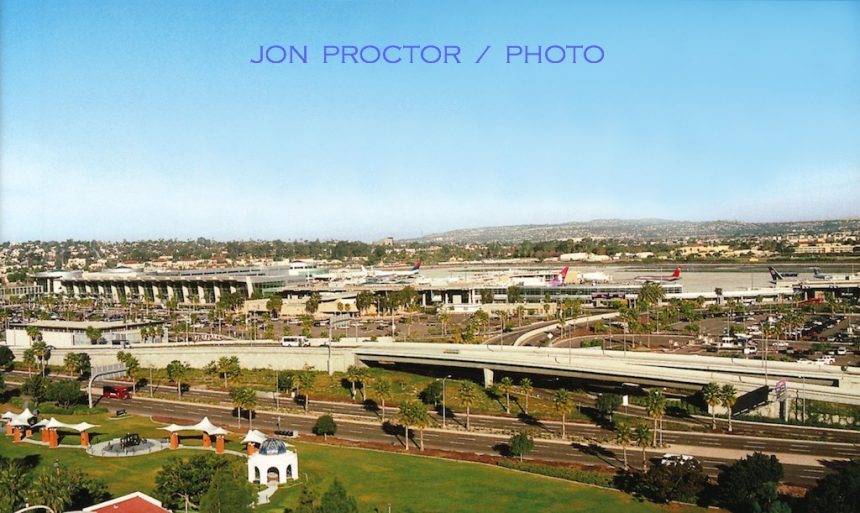

Hi Jon:
Absolutely brilliant collection.
Well done. I am spending hours looking at each photo and reflecting on the enormous changes in our industry.
Best GT
Even with much simpler cameras and wet film, Jon has produced utterly atmospheric photos of airliners during the transition from prop to jet. Of equal importance are the comprehensive notes that accompany each image. Bravo!!
Thanks for sharing your memories with us.
Frank
Hi Jon
Can’t thank you enough for the photos! Gosh I miss those days, I think we all do.
I was able to find a little info on Northern Express Airways. In the April 13 1961 issue of Flight International we see Northern Express was a newly-formed non-sked that acquired its CV-240 from F.B Ayer. April 12 1962 Flight International reports Northern Express had acquired three ex-American Airlines Convair 240s but had since ceased operations.
Hi Jon
Fantastic shots keep them coming love the stories also with the photos.
Thank you very much, incredible photographs! Being able to take pictures so close to those planes is brilliant!
Wonderful – simply wonderful pictures and commentary. Thank you Jon.
Thanks for sharing these high quality historical aviation photos. There remains a gap in my past as I wasn’t lucky as you to have caught a flight aboard one of the sleek CV880/990 “fast jets.” – Best regards.
Great pictures that bring back a lot of memories. My Mom and Dad met while both working at Convair in the early 1950’s. What a great site! Thank You.
Wonderful photos and many thanks for posting! My first flight was in a Delta DC-8 from SAN to LAX in 1964. As I recall, the fare was around $7.00. Little did I know that 8 years later, I would be a crew member (DPS) on a Continental 747!
Great memories! Got any of that massive camo covering of Convair during WW2? They had a golf course up there. I guess that was earlier yet tho.
I also liked the shot of the exhaust screens on the SE end of the runway. Spent a lot of time there in parked cars on the Pacific Hwy side watching the planes land skimming just over our heads and the fence top. Always good for excitement and great memories.
Send more 🙂
Sorry no camo shots; glad you enjoy the site.
Brings back memories I barely recall going to the old terminal dropping my dad off for flights to Cape Canaveral. My father was an engineer for Convair Astronautics and worked on the Atlas Missile program. I remember flying to visit my grandmother in New Jersey back in 67 in what was then the “new” terminal building now known as the East Terminal. My have times changed.
We moved to San Diego in 1943. At that time a camouflage net extended over US 101 from Mission Valley to downtown SD. The El Cortez was “the skyline”. I didn’t fly out of SD until the late 60’s and was appalled at the view landing. It seemed we were going to crash right through the roofs of the apartment buildings at the eastern end of the runway. When the PSA crash happened in 1977, I was in the Washington DC National airport waiting to board my flight back to SD. It was about noon and the papers already had the crash as front page news. When we landed at SD you could have heard a pin drop in the cabin. I did asocial studies report on the dangers of Lindbergh field when I wa sin the 10th grade. Took many pictures of planes landing as they passed overhead the apartment buildings. This would have been about 1952 and I could make out the tread pattern of the wheels.
Thanks for the memories!
Jon – what fantastic pictures and you brought back so many wonderful memories of the old airport and the planes. I spent many many hours with my dad at the airport (he was the assist port director and the airport was one of many sites he managed) and to this day I love watching planes fly overhead/land and take off! THANK YOU so much for sharing!
There is no place like home – no where like San Diego.
Enjoyed your memorable pictures. I didn’t grow up here in SD–arriving in the late 1970s from Texas. I loved seeing the evolution of commercial flights into San Diego. Glad you took the time to take the photos over the years, and even more to post them.
All the best.
Jim Hill
Thank you for the excellent pictures, bringing back terrific memories. With my Parents I lived in Mission Hills after we arrived in 1949, so I remember many of the planes. I worked at Ryan Aeronautical, which is visible in a couple of the backgrounds; each day driving to work in 1959 I passed Convair. As do all that post notes of appreciation to you, I applaud your efforts. Again, thank you.
Great history of the airlines and San Diego. Lots of effort over the years, very much appreciated.
Wow. I grew up in San Diego in the 70s and 80s. My dad used to drive us down to the airport and park to watch the flights arriving and departing from along the fence.
Great record of the airlines and also the changes to San Diego.
Given all your connections with TWA, I was disappointed to not see any TWA planes from the late 60s to our demise in 2001. I often captained 727s, MD80s and 767s into SAN during my career.
Once, in a 767, we were coming in late at night and we had to get in and out quickly as we were coming up against the curfew regarding our takeoff for LAX. I got all the pax briefed on quick action, and we were able to get airborne just 16 minutes after touchdown. Has to be a record turnaround for a wide body.
No other airport has the final approach to buildings I know of. It was common to be able to read the license plates on the cars parked in a multi story parking garage on the right side of final.
great pics, Jon!
Thanks for your kind words, George. The reason you found no TWA shots at SAN (other than the Connie charter flight) is that the airline didn’t begin regular service to Lindbergh Field until June 5, 1980. By then I was long gone from the area.
Jon,
I love all the pics of the PSA Electras. I was a mech for PSA from 1966 to 1969 in San Francisco. I maintained each one of those planes at one time or another. It brought back good memories.
thank you
I love the photo of the PSA and American together. Back then no one would have thought the two would become the New American Airlines.
Pretty cool stuff. I worked at that Convair place from ’78 to ’92 when the damn Soviets quit! Many pleasant memories here of flying and San Diego. Just went down to SAN 2 weeks ago and, I too, didn’t recognize the joint! Once upon a time, PSA (Poor Sailor’s Airline) would have a Father’s Day Deal: They only sold tix to kids to take their dads on a big loop of San Diego. Tickets costs $5 so the kid could afford it. The Convair Liners still make a big thump in my chest. Thank you Jon for being a faithful documentarian of a wonderful place in a wonderful time with wonderful things!!!
tw
Great stories, TW; many thanks for the kind words.
17th shot down of DC-6 90961 I spent a lot of time on as a mechanic and flt crew member as maint rep. this was out of Guam 1969 to about 1975. Acft was flying for continental/air micronesia. Often wondered what ever happened to it.
According to The Aviation Hobby Shop DC-6 production list, it was converted to a freighter in 1978 and flew in South America. Last reported impounded at El Dorado, Bogota in August 1979.
Jon – a wonderful selection of pictures from a byegone era – and good accompanying commentry
What a fabulous collection Jon. Your shots bring back so many memories for me. I only got to shoot at San Diego once but got some great shots. My memories are more from JFK growing-up and my dad working at the USPS airmail Facility there. Every chance I got to ride with my mom to take Dad to work I jumped on. I’d sit on our 5th floor fire escape for hours watching the airliners on final to JFK. Every airline imaginable. Sure wish I had a 35mm camera with lens back then. Man o man! Thanks for sharing my friend and all of your contributions to aviation history.
Glad you enjoyed it, Al; makes the effort just that much more rewarding for me.
Great pics, Jon! What a blast from the past!!
I flew in and out of the SAN “old” terminal frequently as a kid visiting grandma (and vividly recall the cozy terminal and Convair “HOME OF … sign). Years later on my instrument cross country, I recall “breaking out” on the LOC 27 approach amid the downtown hotel buildings, then flew in and out as a flight instructor and charter pilot to the “old” terminal turned JimsAir FBO, and finally as an airline pilot using the “new” terminal.. Great memories of a great time in aviation. Many thanks!
As a college senior at North Texas State, Denton, TX I worked for AA at Love Field as a ticket agent, then after graduation as a management trainee in Los Angeles. The time frame of my airline experience parallels the beginning of this series; I’ve flown most of the aircraft pictured and enjoyed each as a unique experience. A great presentation – thanks for the memories!
John,
Great pictures. Thanks for the memories. Some of the pictures show the old Ryan aircraft company hangar where Lindburgh’s Spirit of St Louis was built. The hangar was torn down a few years ago.
Ray,
What year did you start as DPS? My dad was a DPS at LAX for a couple of years around 1968. My mom was a flight attendant for Continental based in DEN in the early sixties but had to quit back then when getting married. Wonder if you knew them.
Jon,
Wonder full collection of photos. It’s taken the internet aviation buffs by storm. I’ve received quite a few emails pointing to your collection.
Half way down the photos you have a Zantop C-46, N74173. I was hired by Zantop in April 1964 as a C-46 copilot and worked for them until they ceased operations in 1971 (then renamed Universal Airlines).
I first flew 74173 in September, 1966 on a training flight for my upgrade to Captain. There follows a few entries in my log book for 74173. The last flight I had on that airplane was on July 13, 1967.
There is a group of ex-Zantop pilots that I’m in touch with on a regular basis and I will ask them to check there log books for 74173. You might get lucky and find one or both of the crewmembers on the pictured C-46.
Two things that I can tell you about the airplane; It most likely was an empty ferry flight as the tail wheel strut is not compressed to the level a loaded C-46 would be, and secondly, I’m guessing that it was not a military charter as Zantop did not start flying military flights into the San Diego (North Island) area until 1965.
Thanks for the kind words, Ralph! The military charter claim was just an educated guess. With all the aircraft production back then, it might well have been a civilian freight charter.
What great pics! I grew up on Morena Blvd. on the edge of Clairemont in the 50’s, My Dad, a sailor, would put old aviator goggles on both of us and we’d stand behind the backwash deflector off Pacific Highway and feel the power of the 707s taking off. I can just about see our house on a couple of your pics.
My times there interested me enough to get me flying Army aircraft for a quarter century.
Great stuff! Thanks much.
Having grown up in a Lockheed Burbank and Burns Aeroseat family, my aviation career spanned 38 years, from aerospace to commercial aviation. Being an A&P mechanic ramp; finally an engineer, with United Airlines, I’ve worked on most all of what I’ve seen here. Thanks so much, for the photos of yesteryear, my memory banks are at 104%. Fair skies & tailwinds
You’re most welcome, Steve. I posted a few Burbank shots on my LAX page: https://jonproctor.wahsonline.com/lax-through-the-years/
Great photo this just how I got involved in aviation during those day when you were able to get close to the airplanes at the gate
But all is well and I’m still flying to this day
Thank for the memories.
It’s great to see the nice pictures of the airlines and air crafts during the old days.
Thanks for sharing!
Re the TWA trivia. Lighting up the tail. Regarding the LOGO Lights, that is what they were called, cause they lit up the LOGO. I was a Dispatcher at JFK when the first 707 with the lights taxied out. No one told us or evidently the tower. We, Dispatch, got a call from the tower that someone must have left a work light on the horizontal stab that was pointed at the up at the tail!
Thanks for the Memories! I guess Bob Hope said that first.
Jon, Wow, the power of your photographs! My first view of the Lindbergh/Convair complex was about 1948 when the camouflage netting still covered many of the buildings and the stretch of 101 fronting them. It became a point of arrival by air for me beginning in 1949 when I returned from Hawaii by air to L.A. then shuttled down to S.D. Most flights for those of us living in the San Diego area were via L.A. I can’t tell you how many airlines I used from and to San Diego, probably most of those you captured on film plus Mexicana, maybe Capitol, certainly Western, PSA, TWA, National, Pacific Airlines, Continental and once or twice my own plane, a Seneca III decades later. Your pictures of the fence and baggage handling shed are particularly heart warming. My parents stood behind that fence, perhaps a few feet beyond the wing tip waving when I would deplane into the brisk night air after flying home from college back east (via L.A.), 1952-1956. We had to brace our selves from the wind (and fumes) when those planes took off a short while later. Great memories, thank you!
Well, there you go again,Jon! Giving us old dudes in our 80’s an occasion to reminisce back to the early 1940’s when so many of my classmate’s families moved here to work for Convair,then known as Consolidated-Vultee.circa 1943. On family day we were able to see up close, the PBY Catalinas and another year, the B-24s. As a young Marine going through boot-camp-1954- next to the airport, it was frustrating at times, not being able to board one and escape the training. Took my first flight on a “Connie” to Michigan the summer of ’52; what a treat! Played golf with several fellas who worked at Lindbergh Field for most of those airplane companies that required basic services based at Lindbergh. The downed PSA flight in 1977 was the worst…several golfers from our group had the task of sifting through the debris. One of my most interesting flights was during my employment with The Glen L. Martin Company and had to transfer to a smaller airline called Frontier Airlines to reach my destination in Rapid City So.Dak circa 1966..on a DC-3. Jon, you were blessed with such a talent and enthusiasm to capture so many pics from all the airports. This website has been forwarded to my former college roommate from Colorado, who grew up in Chicago and is living there today.
Stay healthy and many thanks for setting up this website for all to share.PAX
Many thanks for your kind words, Stan.
Working at Argonne National Lab outside Chicago, I began flying in 1956 and my first West Coast trips were in 1957. Thrilled to land in San Diego. Flew in DC-3s between the mountains from Salt Lake City to Ogden, Logan, Pocatello and into destination Idaho Falls. The DC-3 only stopped its left side engine at those first three landings. Thanks for these great pictures and memories, Jon.- – Dave
Thank You!! This is a great exhibit. The time you spent to create it is much appreciated.
Loved the pics (I’m still smiling) and remember the old terminal well there on Pacific Hwy. In the late 60’s my Mom would send me to visit relatives in San Jose via PSA. They gave me a Junior Pilot Card to pin to my shirt that had my name and who was picking me up in San Jose. I got to sit up front near the stewardesses while on the plane; they all looked like movie stars and were so nice to me.
What a wonderful collection of photos! I’ve been flying Convair 580s for 25 years and have over 8,000 hours in them. I fly the United N73102 340 you have in your collection and I was one of the pilots that flew it into Memphis where the link goes. We call it the Old Warhorse; we figure it’s fitting because it was built during the Korean conflict and it’s tough as nails. When people ask me what it’s like to fly a 63 year old aircraft, I tell them it’s like driving a 1952 pickup as compared to a modern luxury car; which one do you think would come through a hailstorm in better shape?
I viewed these pictures some time ago and think I know JAC Nelson. We went on SDPD in 1964 and after a few years he went into aviation. I was wondering where he is now if anyone knows. I have moved to Eugene, Oregon to be closer to my two daughters and families. Would like to reconnect with JAC if available.
Thanks. Jim Pilling
I went to La Jolla High with a Jac Nelson and worked for awhile at PSA with his sister, Becky. Not sure this is the connection you’re looking for, but even if so I lost touch with them many years ago. You may be able to link up via the LJHS alumni group; see: https://ljhsalumni.org/
Thanks for you kind words.
I was born at Balboa Naval Hospital in July 1962. That’s why I like airliners. Parents met in San Diego in 1959. Both were in the Navy. Mom got to San Diego in 1959 on American, she remembers its being a prop. My dad got to fly on a Bonanza DC-3 to Yuma. Thanks for the photos.
Oh my gosh. The history. Thanks Jon. I was at US Naval Training Center (NTC) in 1958. I did see, and wanted some times to depart NTC on any aircraft flying from Boot Camp, but I did finish and became a proud US Navy Sailor. Still very proud of the Navy. I lived in Newport Beach when I was discharged, and was given the opportunity to become a Pilot for United Airlines in early 1966. I had the opportunity to fly into Lindberg as a junior “birdman”, and later as a relatively senior Captain. I viewed the 727 photo and know that I had many hours on “Her”. Wow again. Michael Magdaleno writes about his entry into this great world at Balboa Naval Hospital. United would make a very deliberate “S” turns around the hospital to keep it as quiet as possible; needless to say, we were close to the runway and needed to make our detours as safe as possible. Possibly Michael was excited to the great, wonderful noise of jets flying for America and became an aviation enthusiast?
Thanks for the kind words, Garrett!
Jon -Wonderful photographic history. My father, Dick Pickett, moved us ot San Diego in 1960 from LA to open Continental’s operation in San Diego. In the hopes of Continental obtaining CAB approval. They didn’t get it at that time, but the memories are wonderful. You did a great job of showing the progression of San Diego aviation. I remember many of those airplanes since we spent a lot of time at the airports — and still do as a pilot. You probably met our father.
I don’t remember your dad, Rich, but to recall Continental had a ticket office downtown. The airline had a presence with the AA-CO interchange service and was a classy airline, especially in the Bob Six days. Thanks for your kind words; glad it brought back some memories. Jon
I am rarely caught with a loss for words but this is the most incredible collection of airline photos I have ever seen. My father worked for AA for 33 years as an aircraft mechanic in Tulsa, Ok. My first airplane ride was in a DC-7. I became a pilot at the age of 19. Thank you for your endeavor.
Many thanks for your kind words; makes the effort even more worthwhile. Jon
What an outstanding collection of photos depicting what was once a sleepy little Navy town that, according to my Dad, was built by two things-the Airplane & the Navy. I barely remember the “hush houses” that Convair had out by what is now the west terminal at SAN & asking my Dad just what were those funny looking little buildings & just not quite comprehending what he was trying to explain to a quite curious 6 year old. My Dad’s folks lived out in Point Loma-so I got to see a good deal of the airport. Then , when I was in the 1st grade-Dad took my class on a tour of the “new” terminal-including PSA’s MX hangar. I was instantly hooked while watching a 727 do a gear swing. After a stint in the Marine Corps fixing J-79 engines-found myself pumping gas for the majors there at Lockheed Air Terminal. Moved out of SAN in the early 90’s to yet several more airports. Am now looking back at some 30+ years in the business-a licensed A & P now driving a desk as a MX planner.Wonder where the influence came from…………..Thanks for the memories.
Many thanks for your kind words; makes the effort worthwhile. Best Regards, Jon
Fantastic pictures of the airlines operating out of the San Diego. Enjoyed them all. I attended San Bernadino Valley College, where I acquired my A & P tickets in late 1960s. At this time, I met a gentleman who flew for Zantop I believe. His name was Doc Dentice. Did you know him? Would be interested to know if he is still alive. If so, do you know how I could reach him? Thank you.
Thanks for your kind words. I did not know Doc; wish I had met him.
Mr. Proctor, thank you for these amazing pictures and stories of your experiences. Your site has become my virtual “Graceland”. Thank you for all of your contributions and time so that many can enjoy!
Thank you for the kind words. I’m working on the next page – airports of the Midwest – and hope to have it posted in the next few weeks.
I can’t tell you how much I enjoy the wonderful photos of LAX, SAN, Chicago airports, and the NYC airports. It brings me back to when I was a small child sitting in my grandfather’s car in the early 1960’s next to the runway in MIA. The first time I saw an EAL 727 with the falcon on the tail I decided I would somehow work in the airline industry. You have brought back a flood of warm memories, thank you. I did eventually fly a Boeing 727-25 but it was painted purple and had Federal Express painted on the side. I now get to fly in the left seat of a 767 into the very airports you photographed back in the glory days. The approach into SAN is especially fun and challenging! Thank you so much,
Capt Mark Stiehl
Many thanks for your kind words, Mark; makes my efforts just that much more meaningful to me. I’m slowly adding other airports, and MIA will be among them, hopefully later this year.
Jon
Thanks for the outstanding photos! Retiring from AA after 31 Years.
Pardon the late response, Gary; many thanks for your comments; much appreciated. Best Regards, Jon
Jon I love that you are so passionate about and the detail That picture of JFK aboard (Air Force one “Angel” about to touchdown at Lindburg Field in SanDiego is the best i’ve ever seen in 45 yrs of research on JFK a brilliant photo as are the others and storied Well done and absolute credit to you That a fantastic capture of a great moment
Many thanks for your kind words, Mark. I just happened to be hanging out at the airport that day and caught the pictures. In 2012 I visited the US Air Force Museum in Ohio and was able to tour SAM 26000 interior. Again thank you.